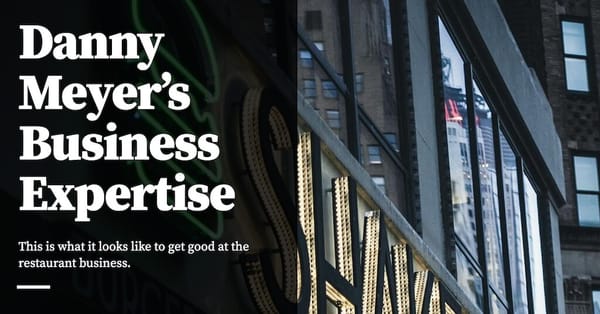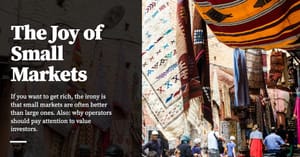Let's break down Danny Meyer's business expertise as an exercise in biography reading.
Shortly after publishing a case on Union Square Hospitality Group (USHG) last week, a friend pinged me, saying that they had enjoyed reading founder Danny Meyer’s biography Setting The Table — but that “it was more business-culture/ memoir-focused instead of business / operational.” The implicit message was that Setting The Table isn’t particularly useful for a general business operator. Another friend reached out and said that they believed Meyer’s story was too specific to New York City to be broadly useful — citing the Alchian-Allen effect.
I disagreed with both critiques, though I believe they are mistaken in very interesting ways. The second critique is right in that Meyer’s principles or lessons are almost certainly overfitted to his specific business ... but then that's true for any business story or biography. (You do not read history for lessons). That does not mean that reading his story is useless.
The first critique is more interesting. If you read Setting The Table as a business memoir (which it is!), or as a reflection on systematising and then scaling a particular hospitality culture (which it also is!) — then, yes, you’re not likely to get as much out of it. But if you read the book as an accounting of business expertise in a particular context, and how Danny Meyer built each aspect of his expertise in that context ... then I think you have something interesting.
You have a case study of what gaining business expertise can look like.
The Pitch
Danny Meyer is interesting to study not because his story is easily replicable in other industries, or even in other locations in the same industry — but because so many elements of his business expertise is legible to those with even relatively little business experience.
There are two reasons for this:
- The restaurant business is a simple one to understand. Unlike, say, transatlantic shipping, market making, or (god forbid) ad exchanges, food & beverage (F&B) businesses are something that everyone has some experience with. We have all eaten at cafes. Some of us have had fine dining experiences. Conceptually an F&B business is simple: you hire people to make and serve food, and then you sell that food to diners. Sometimes you serve diners on premise; other times you optimise for deliveries. The business is simple. But it is not easy.
- The restaurant business also happens to be soul-crushingly hard. It has low margins, high fixed costs, is somewhat cyclical (depending on the exact category), is typically run at the mercy of landlords, and is reliant on recruiting in meh labour markets. Nearly everyone I know knows someone who has started a cafe or a restaurant or a bar and failed. On the other side of the entrepreneurial coin, it is a common experience to have a beloved eatery close on you; it’s also a common phenomenon to observe ice cream shops or bubble tea stores or cafes pop up, en masse, like mushrooms after heavy rain, only to die away mere months later.
This combination of attributes means that the F&B industry is uniquely interesting from a business educational perspective. Everyone understands it. Many white-collar workers dream of retiring from spreadsheets to start a bar. Few actually get good enough to survive.
What does business expertise in this domain look like?
The Restaurant Business, Briefly
A typical restaurant business has three major cost buckets. They break down to be roughly around a third of total costs each:
- You pay a third of costs to rent and utilities.
- You pay a third of costs for ingredients and other consumables.
- You pay a third of costs for labour (waiters and cooks).
There are other costs, of course, but those are minor compared to these three major buckets.
The three costs explain a lot about the restaurant business.
You don’t renegotiate rent very often, and typically you are at the mercy of your landlord (restaurants who own their own property or who have a special deal with the landlord are thus structurally advantaged).
Unless you’re very large, you also can’t negotiate with your ingredient suppliers, so you’re mostly stuck with whatever they charge you. (F&B suppliers have seen many restaurants die and tend to be very savvy about your risk of failure; they are typically paid net-60 to net-120 — meaning 60 to 120 days after delivery of goods to your door. In Kitchen Confidential Anthony Bourdain observes, wryly, that if there’s even a whiff of death about your business, savvy suppliers will suddenly demand cash-on-delivery and thus cause you a great deal of grief, especially if you can’t deal with the cash flow problems that ensue. Such is the cut-throat nature of the restaurant business.)
Most F&B businesses learn to cut costs in the labour bucket. If business is bad, they fire folks. This in turn means that the labour markets that most restaurants hire from are just atrociously bad: you get people who are willing to be treated in this horrible manner.
A good restauranteur, then, must be savvy in managing all three costs, must find some way to recruit, train, and retain talent, and must ensure that their restaurant will attract, and satisfy enough customers to survive. This latter thing is clearly a function of understanding the market you’re in — which in Meyer’s context is often neighbourhood-level competitive dynamics.
This cost structure also explains why many restauranteurs are interested in driving more business, as opposed to optimising the hell out of their cost buckets. One concept that’s useful to have is the notion of ‘table turns’ — that is, if you serve patrons on your premises, how many tables do you have, and how many groups of diners (turnovers) do you get per table? The faster a group sits, eats, and leaves, the higher the table turns. An industry rule of thumb is that a healthy number of table turns per night is three, though this depends on the size of the restaurant and the overall cost structure of the business. It also explains why the tables and chairs at McDonalds’s aren’t particularly comfortable to sit at.
All of this is to say that it’s actually a worthy exercise to look at restaurant businesses around you, in order to see how they’ve adapted to these various constraints. Different F&B businesses have adapted differently. McDonalds solves its constraints by serving a particular style of food with low-skill labour, by using the franchising model, and also by owning large tracts of its own real estate. Eleven Madison Park (a fine-dining restaurant) solves for these constraints differently.
So ... how does Danny Meyer deal with all this?
Originally published , last updated .
This article is part of the Expertise Acceleration topic cluster. Read more from this topic here→





